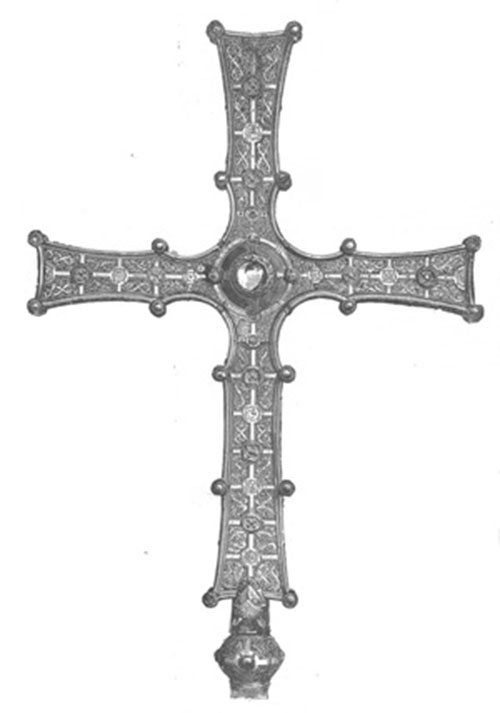Cross of Cong - Irish Pictures (1888)
From Irish Pictures Drawn with Pen and Pencil (1888) by Richard Lovett
Chapter 1: Ireland’s Eye … continued
« Previous Page | Start of Chapter | Book Contents | Next Page »
The Ardagh Chalice deposed what is known as the Cross of Cong from the proud position of chief among the works of art in the museum. This is a famous relic, dating from the Middle Ages, enshrining and illustrating, as so many of the articles in this fascinating building do, the traditions and habits and life of the early Irish Church. This cross was constructed, as one of the five inscriptions upon it states, for the following purpose: 'In this cross is preserved the cross on which the Founder of the world suffered.' In other words, it is a reliquary, and at one time was believed to contain a piece of the cross upon which Jesus Christ suffered 'the just for the unjust,' in order 'that He should gather together in one the children of God that were scattered abroad.' It was made by order of Turlough O'Connor, father of the last king who ruled Ireland prior to the Norman invasion, about the year 1123, and placed in the Church of Tuam, during the Archbishopric of Muiredach O'Duffy, who died in 1150. This is clearly shown by the inscriptions still decipherable upon it. It was transferred to Cong either by O'Duffy, who died there, or by order of King Turlough O'Connor, who founded and endowed that abbey. At the time of the Reformation it was concealed in an oaken chest, and early in the present century a parish priest, the Rev. Mr. Prendergast, found chest and relic in a cottage. From his successor Professor MacCullagh bought it, and presented it to the Museum.
The shaft is thirty inches high, the arms eighteen and three-quarter inches broad, and it is one quarter inches thick.
It is of oak, covered with plates of copper. On the central plate of the front at the junction of the cross is a large crystal, through which what was supposed to be the true cross could be seen. Eighteen jewels were placed at
regular intervals, and of these thirteen still remain. Two out of the four beads which originally surrounded the central boss remain. The lower part of the shaft is the head of a grotesque animal, beneath which is the richly decorated ball containing the socket into which the pole was inserted by which the reliquary was borne aloft on processional occasions.
« Previous Page | Start of Chapter | Book Contents | Next Page »

